Rudy Rucker's Blog, page 30
September 5, 2014
“Endless Road Trip.” “4th D.” Author’s POV.
So I finished that painting I was talking about in my last blog post.

“Endless Road Trip” oil on canvas, Sept, 2014, 30” x 24”. Click for a larger version of the painting.
These are my alien characters Flook and Yampa, driving their hover car across the unending plains of the unfurled “Wacker World” Earth. Admiring a capybara and some squirrel monkeys. My heroes Willy and Alma are along for the ride, but you don’t see them in the picture, partly because I didn’t feel like struggling with the human form—I just went for some expressionist zigzag aliens.
This place where they’ve stopped—way, way west of California—was going to be called the Land of the Ants, but then I got into a capybara-and-squirrel-monkey routine, so that’s what’s in the painting.
I like how the guy Flook on the left looks, he’s like a cartoon-character tough guy with a whiskery jaw, and the round thing on top of his head might be a derby. And Yampa on his right, she’s looking at the squirrel monkeys and the capybara and saying, in a screechy discordant voice, “Aww, aren’t they cute!” Maybe her voice is so horrible that one or more of the animals dies in some weird way. Turns into dark energy or some such.

There’s a nice new reprint of my nonfiction book The Fourth Dimension, from Dover Books. The subtitle is “Toward a Geometry of Higher Reality. There was also an edition where I used a different subtitle, “And How To Get There” — but these are the same books. The Fourth Dimension is probably my all-time best-seller, maybe a quarter million of them out there. Over the years, scores of people have written me to tell me that this book changed their lives. It’s one of my main works.
I’m happy to see it reissued by Dover, as I got my start studying Dover’s inexpensive reprints back in Louisville, Kentucky, in the late 1950s and early 1960s.
The Fourth Dimension in Kindle and paperback on Amazon..
Go git it.
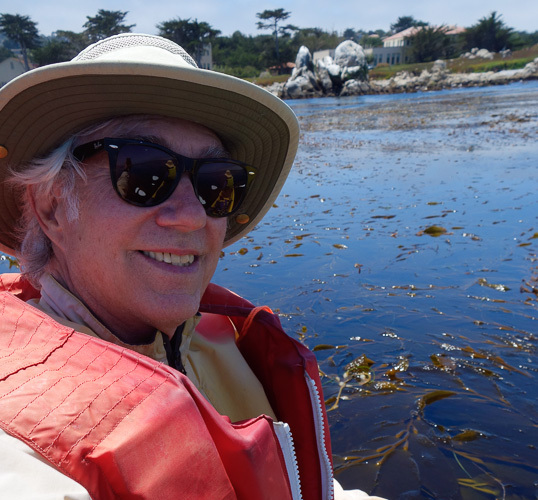
Back to the new novel I’m trying to start. Wacker World. Today I’ll share some semi-technical thoughts on writing. When starting a novel I always have to decide about what point of view or POV to use. I always use either first-person (1POV) or third person (3POV).
Writing first person or 1POV is probably the easiest style. I used it in Jim and the Flims, and in The Big Aha. A no-brainer, like falling off a log. If you get the right narrator voice going, it works very well.
This said, the first-person point of view carries some risks.
(Risk 1) In that 1POV filters everything through narrator’s attitudes and language skills—and this can be an irritating feature if it’s done wrong. I don’t to see page upon page of gushing, slobbering, emoting—what I call repetitious wheenk. The first-person narrator can suck all the air out of the room.
(Risk 2) When using 1POV, there’s a sense that you need to impose the narrator’s linguistic limitations and quirks on the text. This can be okay if the author makes the viewpoint character fairly interesting, rounded, and non-generic. But it’s very risky to try and narrate a 1POV story in dialect. Unless you’re Mark Twain writing Huckleberry Finn. Although, come to think of it, I did something like this in my shot at a great American SF novel, The Hollow Earth, which is 1POV from a boy from Killeville, Virginia.
(Risk 3) Another issue with 1POV, is that the author may feel it necessary to have a frame-tale explanation of how and why and when the character is telling us about his or her adventures. You say that the narrator is reminiscing about the events afterwards, or documenting them for the record, or narrating them to a rapt audience, like that. But you don’t have to do the frame-tale, and, if done wrong, it can be of corny and obtrusive. Sometimes it’s better to just have the reader be in the narrator’s head with no explanation.
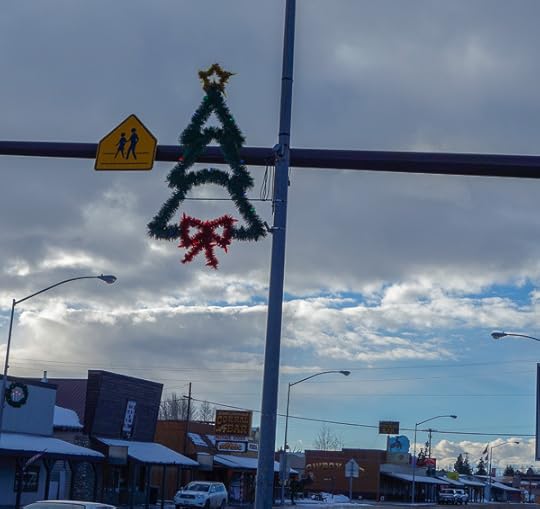
A final point to make about 1POV is that, if you want a reportage feel, you can have several characters telling the story from their points of view, or even interrupting each other, as if doing a joint interview. This could be fun. (Cat calls, loud farting sounds, sarcastic laughter.)
Regarding third person point of view or 3POV, here’s a link to a nice little essay by a writer called Michael Neff, he talks about the levels of 3POV, distinguishing 1POV, far 3POV, and close 3POV, which we can abbreviate as C3POV.
I like the C3POV, where my viewpoint is closely focused on one single character at a time. I’m following one character and seeing his or her thoughts. The C3POV is also called “third person limited point of view” or “deep” third-person. It’s like following a movie actor with a camera.
If you do C3POV instead of 1POV, you’re free to use a more literate style than the character would—I think of John Updike’s magisterial Rabbit tetralogy, of the tints and shades of feeling that are assigned to the everyman-type Rabbit Angstrom.
Note also that you’re free to adjust the “closeness” of the C3POV over the course of a scene, at times getting in so close that it’s as intimate and telepathic as 1POV.
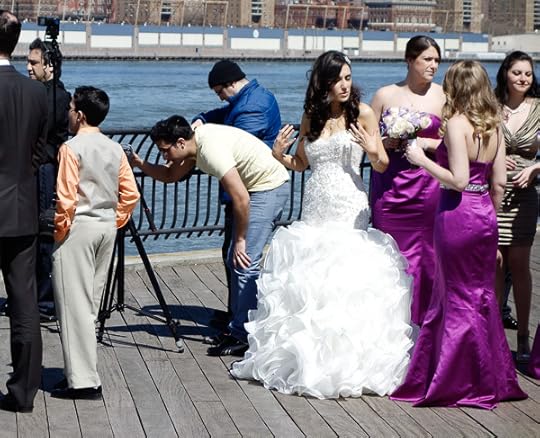
Over the years, I’ve come to enjoy using what I might call rotating close third person point of view, or RC3POV. The idea is that I shift the close third person POV from character to character. I don’t do the shifts within a scene, I cycle from one character to another from chapter to by chapter. I did that in Realware, Postsingular, and Hylozoic. I plan to use RC3POV in my upcoming Wacker World, that is, I’ll have close third-person C3POV on my character Willy in some chapters, and have the camera on my co-starring character Alma in other chaps.
Thinking back to Postsingular, I rotated the C3POV focus from section to section within the chapters, using seven different points of view in all. And in one single section I went kaleidoscopic on the reader’s ass, hopping one head to the next without even signalling the changes with section breaks.
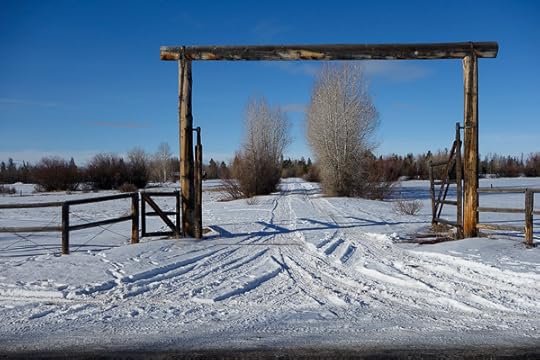
It’s risky to do head-hoppping, or “wandering POV,” although Thomas Pynchon and Phil Dick often do. Pynchon can do it because he’s a supreme and god-like master, and Phil, well, you never know. Phil wrote really fast and he might not even have noticed he was doing it. But getting Phil’s reckless downhill-racer thing going is a skill in itself.
Through the dancing sunlight, and into oblivion.
September 2, 2014
Entering Wacker World
Recently I retweeted a photo of a capybara being groomed by some squirrel monkeys. It was just something that I’d seen retweeted by someone else.
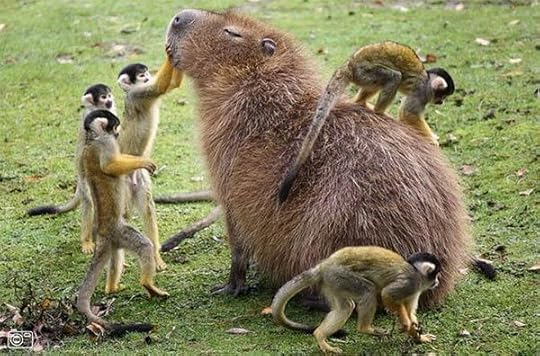
This became my most widely circulated tweet ever, with maybe a hundred thousand views. Part of the appeal must be that the scale is so odd—you think of those primates as being fairly tall, but you think of furry, lumpy animals as being small. Turns out capybaras are the largest rodents in the world, running up to four feet tall. And squirrel monkeys are tiny. The amphibious capybaras live in the mouths of Brazilian rivers. The Brazilians eat them, and they refer to them as “fish,” which makes it okay to eat capybaras on Friday.
There’s something Boschian about the image too, those odd little “men” like clerics attending to the massive furry creature. And the capybara looks so relaxed, so at ease.
These days I’m working on an outline for a fresh SF novel with the working title Wacker World. I always like to have at least two odd features of the world being presented in an SF novel—which was a practice advocated by the ascended master Phil Dick. In Wacker World one odd thing is that our Earth has somehow been transformed into an endless flat world that you can drive along on forever. For millions and billions of miles. Encountering, as you go further and further, ever-new alien civilizations. I call these flat worlds Wacker worlds. There’s a number of them in our universe.
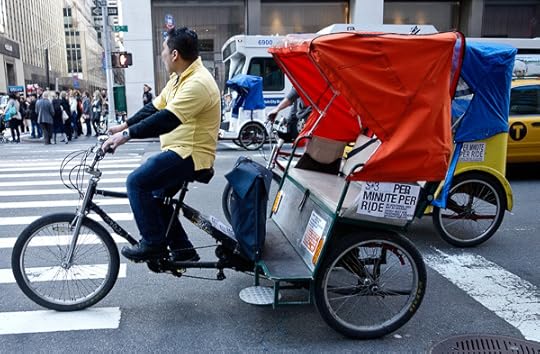
By way of jogging my imagination, now I’m working on a painting that shows couple of aliens on a very long roadtrip, and they’re looking at the creatures from that capybara tweet photo. That’s not my new painting above, of course. I’ll be posting the painting in a week or so when it’s done.
The aliens in my painting—I see them riding in a purple hover car that can hit speeds of up to, say, a million miles per hour, which is no sweat, given that limitative speed of light is well over six hundred million miles per hour.
Anyway, these aliens are cruising along in their car, and they’ve got a teen boy and a girl with them, my book’s young heroes, currently named Willy and Alma. This first place where they’re stopping—way west of California—was going to be called the Land of the Ants, but then I got into capybara-and-squirrel monkey thing, so that’s what’s going to be in the painting and probably in that first-stop world in my novel…not that my novels always stick to the things I paint for them in advance. The painting is more of a way of stirring the pot than being a way of making any kind of precise outline.
Speaking of ants, we had an entomologist named Phil over at our house this weekend, and he was telling us about Central American big-eyed Acacia ants. These guys live inside the bulbous thorns of the bull’s-horn acacia, in a mutualistic relationship with the plant. The plant gives nectar, housing, and food particles to the ants, and the ants sting the crap out of any herbivorous mammal that dares to try and graze on the bull’s-horn acacia.

Anyway, I’m having fun starting work on a novel. Joyous. Working out things like the illumination and the weather. Making little sketches and searching the web. To speed things up, I’m plugging my brain directly into my computer.
There’s a Rancid song, “Radio,” from Let’s Go, with the line: “When I got the music, I got a place to go.” Or, as NOFX says it in their reggae cover of the same song, “When I got the music in me, I got a place I can go.”
I pray to the Muse that I can really get it rolling. I was wondering what kind of magical alien-type wand was going to transform our little round planet Earth into this infinite roadtrippable plain. These plains are, like I say, called Wacker worlds because they’re named after the astronomer Ed Wacker who first spotted one in distant space.
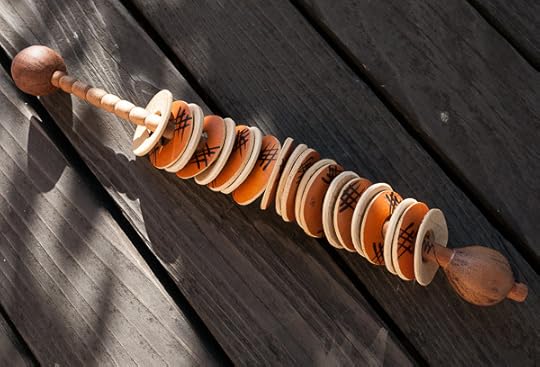
I knew that I needed some gimcrack that can unfurl our world. Initially I visualized a whirring gizmo with higher-dimensional parts that wobble in and out of visibility. But it’s hipper and gnarlier to have the rattle made of natural materials, as opposed to being made of machined metal. It’s made of something like alien plants or like scraps of hide from alien animals. But it’s still five-dimensional.
So the Muse checked in and led me to got this doohickey of a cool rattle from Ghana from a defunct curio shop called Gina’s on Main Street of Los Gatos. The world-unfurling Ghana rattle has disks of gourd skin, like washers, and they’re mounted on a stick with regular bumps in it. The washers are slightly concave, and they’re in pairs, with the hollow sides facing each other, and with symbols branded onto the convex sides. When I tilt the rattle, they march down along the axis, orderly but jostling, tripping over the gentle bumps on the axis rod, moving in a rolling, plausible gait. Like the legs of a centipede.

I also got a rattle like a giant scrotum, wonderfully wrinkly and gnarled, with a dick-like stalk protruding and drooping towards the base of the sac. A little wood plug closes off an irregular hole in the side scrotum, a hole, through which the rattle-seeds were inserted. The surface is hard and shiny, with patches of gourd-pith that haven’t been fully scraped off. Maybe this rattle does something different from turning Earth into a Wacker world.
And I got giant gourd wrapped in a fishnet with cowrie shells at the knots. I’m loaded, dude. I’m equipped.
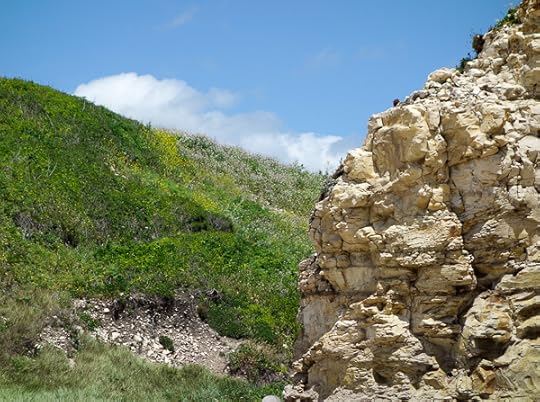
How big is a Wacker world, by the way? Well, they have to reach out to the limits of visible space, which is about seventeen billion light years away. Call it an octillion meters. Now, space might go on endlessly after that. Forever. We don’t know. The Big Bang might not have been a point-like event. It might have been more like a flash filling an infinite plane and lighting up infinitely many stars. Zzzzap!
People sometines rush to the conclusion that if you drove, like, a puny trillion miles on a Wacker world, you’d be bound to find a virtually identical copy of Earth.

But the odds are much, much longer than that, as Max Tegmark explained in his 2003 article, “Parallel Universes.” (You can find it here as a PDF. And a shorter version appeared in Scientific American.) Your odds of finding a copy of planet just like Earth within the confines of visible space are considerably less than googol to one. (A googol is a written as a numeral 1 with a hundred 0’s after it. Quite a big number.)
Call the “Hubble length” the diameter of our visible universe. You’d in fact have to cover the ground of perhaps three to the googol power Hubble lengths to be confident of finding another “Earth.”
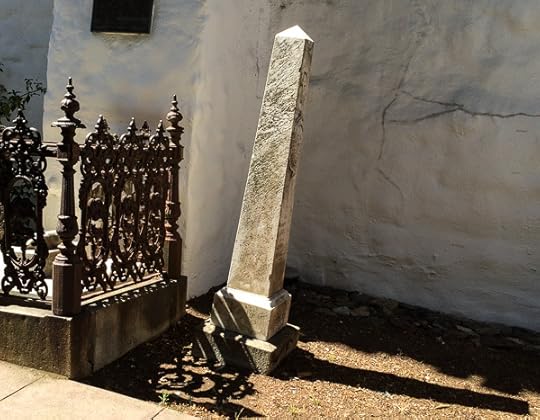
Re. big flattish worlds you can tool around on, Larry Niven’s Ringworld depicts an incredibly large place. One of the joys of this series. Lebensraum!
And in Charles Stross’s wondrous, epochal story “Missile Gap,” a copy of Earth has been peeled like a grape, with the surface/skin pasted onto a disk that’s millions and millions of miles across, with a zillion oceans and other continents, many of them inhabited by alien species. Supremely great story, with a lot to think about. But there’s continents with oceans in between them, so you can’t just drive—instead Stross uses a cool Soviet-era-dream nuclear powered giant airplane. The story appears in Stross’s anthology Wireless, and can also be found free online.
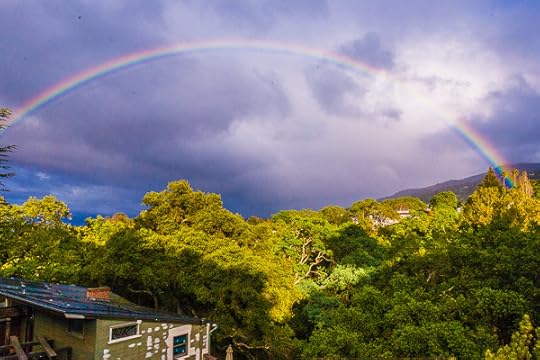
Even though the diameter of the Stross disk is probably bigger than you can drive in a lifetime, the disk is finite and it has an edge. I don’t like edges. If you have an edge, you can do a number where we reach the “edge” of the world and it’s like the edge in C. S. Lewis’s Prince Caspian, with a frozen wave. Or the classic cartoon thing of ships sailing off the edge. Stale. But I don’t want an edge. I want an endless roadtrip. Especially after driving to Vancouver and back.
With an endless roadtrip, you’re, like, forever on the golden plain leading to Mount Shasta. Never frikkin’ having to be back home to your workaday world.
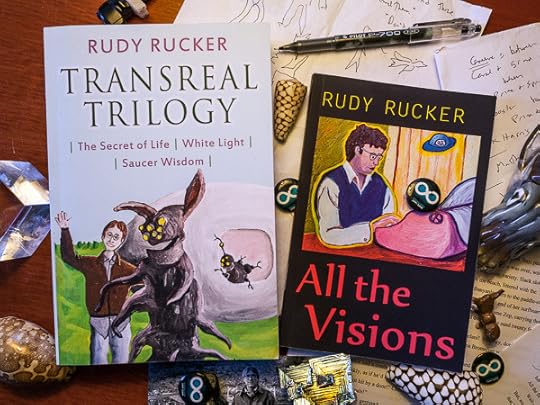
Speaking of that workadaddy world, I’ll close with a commercial message: my new three-novels-in-one ebook Transreal Trilogy is on sale for $1.99, and my 1980s memoir ebook All the Visions is on sale for $0.99. Go git ‘em. And puh-lease, if you buy one of my books from Amazon and you like it, post a comment!
August 19, 2014
Roadtrip #5. Vancouver, Coupland, Back Home.
After Ottawa, we went back and spent two nights in Vancouver. We stayed at a century-old, not-too-expensive place called the Sylvia Hotel, next to the water at English Bay Beach.

I’d been planning to meet up with my writer friend Bill Gibson, but as it happened, the page proofs for his next novel arrived at the same day we did, and he only had about three days to fix them, so we couldn’t connect. His two recommendations: Japadogs and the Douglas Coupland show at the VAG (Vancouver Art Gallery).

I had some doubts, but I did get a Japadog on the street—these are gourmet Japanese sausages, many levels above what you expect from street food. Bill loves Japanese things anyway, you might say it’s a cyberpunk country, with the Uniqlo clothes and the Muji housewares. While in Vancouver, Sylvia and I went to one of the best sushi restaurants ever, a place called Tojo’s.

The VAG museum is really a nice place, so European-feeling and civilized. A huge gray stone Victorian pile with a lovely patio cafe, no dirt, no Muzak, pleasant staffers, good food. Sometimes in Canada I’d get the feeling that in the US we’re living like wild animals.
Douglas Coupland lives in Vancouver, the author of Generation X and numerous other novels. One of an aging author’s last resorts is to become a visual artist—like Henry Miller or Lawrence Ferlinghetti, for that matter, me. (Yesterday I revamped my paintings site, making it mobile friendly! Coupland is taking this route with characteristic éclat and élan. I’d had some doubts about his very large show—as well as about the Japadogs—but it’s great. It consists of various rooms filled with riffs he’d done on one art historical theme or another. The one shown above it kind of a masterpiece, a Cubist composition including Twitter icons and such.

Coupland also had a couple of rooms of Lego constructions. This one kind of nails the uniformity of life in a suburban development. Sure this is a stale, whipping-a-dead-horse kind of theme, but the realization of it as identical Lego houses with identical Lego cars is kind of perfect.
And there’s a very funny room of repurposed objects expressing “Canadianness.” Like a locked freezer with a pool of blood on the floor under it, or couches with Hudson’s Bay plaid coverings.

And a really wonderful display, right in the first room, the walls lined with thin gray shelves, and lined up on the shelves are a zillion little bright bits of … plastic crap … that Coupland’s amassed, like parts of toys, or packaging, or game pieces, or wrappers, each of them just so, just sitting there, not attached, they drifted in and landed here, like debris on a beach by the ocean of the Real, and who’s to stop the work’s owner from nudging them or rearranging them, the road goes on forever and the party never ends. (I’m only showing a detail of the work here.)
And a room of Mondrian-like works with those 2D postal barcode thingies in the corners, I think they’re called QR codes. Not all of Coupland’s pastiches work—for instance, his two or three attempts to mimic Roy Lichtenstein’s Ben Day dot mirrors are weak. At times you get a sense that he just put in every single thing he’s ever done into the show. (Clearly any snarkiness on my part is authorial envy.) The overall impact of the show is massive, and I think it’ll get big play when it travels from Vancouver down into the US.

Coupland included a large outdoor sculpture of his head, called “Gumhead,” and people were encouraged to stick wads of chewed gum onto it. Kind of great. So interactive. Andy Warhol would have liked the show, and in fact Coupland speaks of himself as a Pop artist, and he even had a piece consisting of abbot a dozen of blond wigs sandwiched between two sheets of glass—wigs like our man Andy wore. I can’t resist mentioning that Marc Laidlaw and I wrote a story about Andy online, it’s called “The Andy Warhol Sand Candle.”

Wandering around Vancouver we came across what you might call a “floatplane airport” in the harbor, with planes buzzing off every few minutes. Fun to watch from the grassy, civilized waterfront park nearby.

We also hit a tourist-attraction spot called Granville Island, really not that great, and without many locals around, but I got a few photos, like these vines dangling from the roaring overhead Granville bridge. And there was a great food market.

Mysterious art project seen through a window of the Emily Carr University of Art at one end of the island.
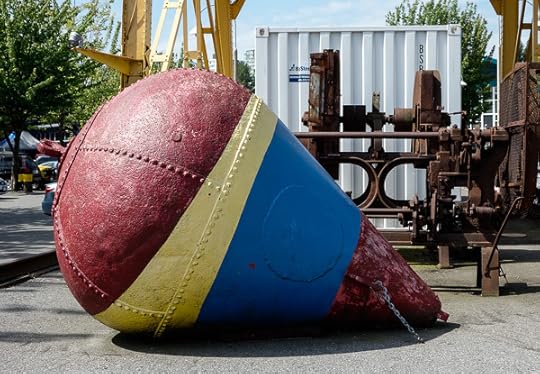
And a big buoy or float hauled up from the sea to be an art object.

Heading south from Vancouver on I-5, pounding the Red Bull, we nearly got killed in the insane rainy-day traffic in unbelievably congested Seattle. Switched over to a mellower back road Route 9, leading to a little town called Sandy. I had this moment of Coupland-initiated Pop Art ecstasy walking around the mall parking lot at sunset by our motel. Seen through art-eyes, there’s great beauty and semiotic fun in the so-familiar iconography of the North American sprawl. A motor boat on a trailer with the low golden clouds! Photo taken with an iPhone, yes! Thank you, Doug, for opening my eyes, to this flash of ecstasy.

Then on to Bend, Oregon, which has become something of an outdoor mall, and down into the sparsely populated Klamath Falls, , one of those lifeless, emptied out country towns. This is a Klamath Falls alley. My Louisville high-school pal, Mike Dorris, who later became a famous author, had some Native American ancestors that hailed from the Klamath area. Modocs. There’s even a town called Dorris nearby I’m always a little mournful when I think of Dorris, as he’s not alive anymore. I wish he was still here. By now he’s missed out on a lot.

The streets of Klamath Falls were empty, with some cool old Art Deco buildings, like this one, the Wilson Building, with pine cones and cow skulls. I always tell Sylvia I want to resettle into a town like this, and she shudders, and I think of Wm. Burroughs’s phrase about his travels through South America in Yage Letters, “nightmare fear of stasis.”

And then we got into a lovely drive across high desert fruited plains towards Mt. Shasta in the golden late afternoon light, staring at that mountain for 60 miles driving towards it, feeling like Neal Cassady and Luanne Henderson, bombing along the two-laner, road trip paradise, what a thing to see a mountain from 60 miles away. I’m so happy/lucky to still be around, running one more trip like this. At the end of the day we reached for good old Weed, California, home of the vintage Hi-Lo Motel and Diner. Fabulous Weed. I always try to stay there, the town name tickles my fancy, and it’s right near the base of sacred Shasta.

And now back to the Los Gatos library. Home, sweet home.
August 15, 2014
Roadtrip #4. Totem Poles.
I’m still mentally processing our roadtrip/plane-trip in Canada last month. And generating a few more posts. Today’s post is about the totem poles we saw in Canada.

“Beak Totem,” oil on canvas, August, 2014, 16” x 20”. Click for a larger version of the painting.
Dig the beak on this totem god. I’m not sure what kind of bird he is. Eagle? I just finished painting him today. The background is drawn from a sunset view over Lac Desert, the place that I talked about in the previous post. If you want to buy “Beak Totem,” check out the price-list on my Paintings page.
While in Ottawa, we went to the Canadian Museum of History, all kinds of stuff in there. The place was formerly called the Museum of Civilization. We focused on the First Nations art, like masks and totem poles, some of them antique, some of them newer pieces made by Native Americans, mostly on the west coast of Canada.

I really liked this sculpture of a sinister beaver god, made by the Haida artist Jim Hart in 1993. The object is meant to be a stand on which to place a chief’s coffin.
A side note, we saw the first-ever Canadian stamp, and it has a beaver on it. The Algonquin man, Don, who was our fishing guide told up in Lac Desert, told us a funny beaver story. At certain times of the year, beavers travel, going across the land looking for a new pond or creek to make their own. Don saw a beaver in his backyard, looking over his spring for possible colonization. Don chased the beaver off by brandishing his Whipper Snipper weed cutter. The beaver slapped his tail (their method, in the water, of alerting fellow beavers to danger) and then banged his nose on the ground—in a frustrated attempt to dive. And then the beaver moved on.

I’m very big on crow masks. Those giant beaks! I love fairy tales about crows and ravens as well. If I was ever reincarnated my three top choices are: crow, brown pelican, and a Big Sur cow.

Carving of a fish.
The Canadian Museum of History has a really large hall on one side, with ceiling that’s several stories high. About thirty totem poles are on display here, most of them dating from the late 1800s, which was the heyday of totem-building in the Pacific Northwest. The heyday only lasted a for a few decades.
Before the traders arrived, the west coast Native Americans were carving stone or wooden figurines with primitive knives. But then – then the sailing ships came, and the strangers brought steel axes. And—wow! Huge totem poles, from Oregon to Alaska!
But the traders brought syphilis and smallpox. And the missionaries banned the natives’ religion. The world they knew by heart become someone else’s “New World.” And the white man carried the totem poles off to museums.
I’ve always wanted to write an SF story based on this scenario, and these days I’m working on such a story with Bruce Sterling—the quote above is taken from a draft. In the story, some aliens bring humanity some incredibly powerful tools, and we create amazing stuff, and then it ends with unexpected outcomes.

A view of that pole I painted. One of the totem poles in the museum had a note saying that they’d helpfully repaired the pole, moved it to the museum, and given the Native American village a reproduction of the pole—cast from plastic, I think.
I saw a giant salmon on one totem pole. You see beavers, frogs, wolves, crows, eagles and bears as well. Plus the legendary bird they call a thunderbird—the thunderbird is a little like Jove or Thor, he beats up storms with his wings and sends out lightning bolts.

As a side note, my brother’s wife Joanie has a few nice pieces of Inuit art in her cabin. Like this seal. I remember carving a wooden seal in shop in the eighth grade. I didn’t make mine curvy enough. I liked holding this stone Inuit seal. A power object. A little sculpture like this is in some sense like a phrase or an image or a paradoxical bit of logic—a tradition-polished thought that you can caress and ponder.

A nice curved ramp in some dusty recess of the Canadian Historical Museum.

And a great mural, Morning Star, on the ceiling of the big totem-pole hall, by native artist Alex Janvier. Here’s a video clip of the unveiling in 1993.

Kitwancool by Emily Carr. 1928. Oil on Canvas. About 32″ x 40″. At Vancouver Art Gallery.
In the first half of the twentieth century, the artist Emily Carr, working around Victoria in British Columbia, did some really wonderful paintings that included totem poles and First Nations art. On our way back home, we saw several of Emily Carr’s paintings in Vancouver Art Gallery, and in the past (on an earlier trip to the Northwest) we saw a bunch of them at the art museum on the island of Victoria.

Here’s the photo that I used as a model for my totem pole painting—I didn’t want to post this image right next to my painting, as the full-blown funky original blows me out of the water. This said, I’m happy with the way mine came out. I think I’ll do a bigger totem pole painting next week, drawing extra inspiration from Emily Carr on this next one.
August 3, 2014
Roadtrip #3. Canadian Lake.
We drove up to Vancouver and flew to Ottawa. Met my brother there and went up to a cottage on a lake called Lac Desert. Deserted, but no desert!
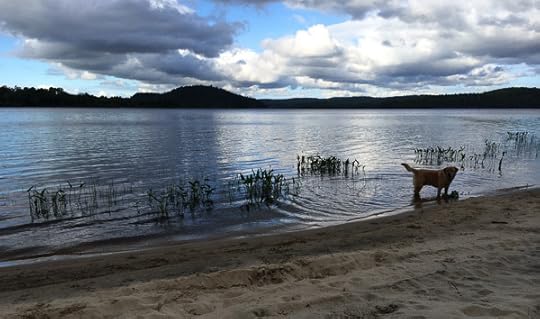
Nice to be so totally off the grid.
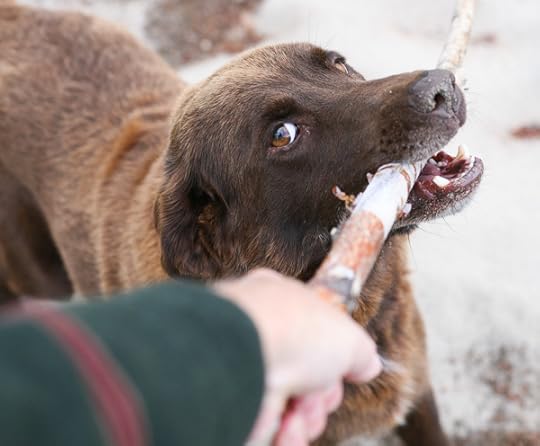
I played with the dogs and they got hyper. Love that crazed, rolling eye.
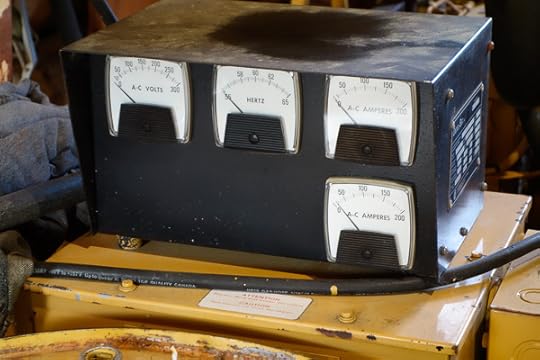
The only way to get to the cottages was by boat, and they had a generator for power—it went off around 9:30 at night.
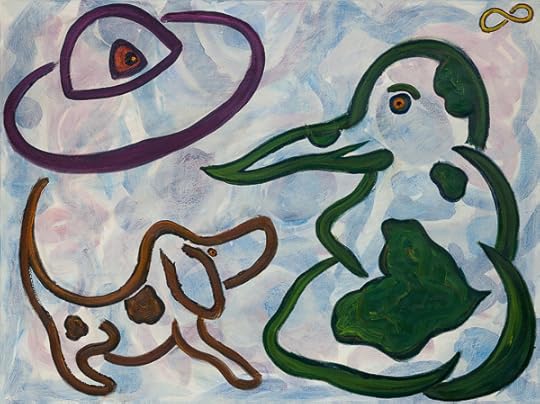
“Dog UFO Gub” acrylic and oil on canvas, July, 2014, 40” x 30”. Click for a larger version of the painting.
Getting totally out of sequence for just a minute, here’s a painting that I almost finished in July, right before our trip, and which I just finalized today. I used a new technique for it—I made a squiggly abstract underpainting with quick-drying acrylic paint, then I covered that with a white haze/glaze of acryulic paint, and then put some free drawings on top with thick oil paint. The underlying subdimensional reality in the background. And in the embossed oily top world we see my dog Arf, a UFO, and the spotted gub who stars in my novel The Big Aha. Also an infinity sign in the sky. I find it pleasing to look at.
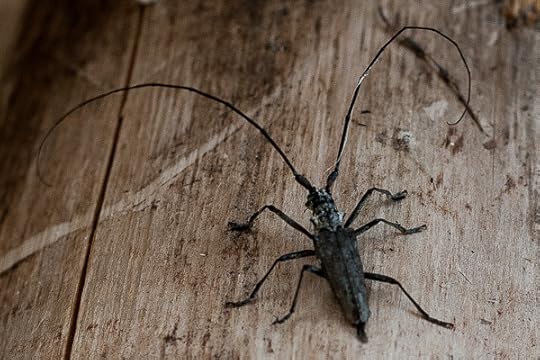
We saw a beetle with really long antennae. My brother’s new wife Joanie said these beetles bite, and they like to eat wood. I didn’t touch him with my bare fingers, instead used the ever-present all-purpose cloth hankie I carry in my pocket.
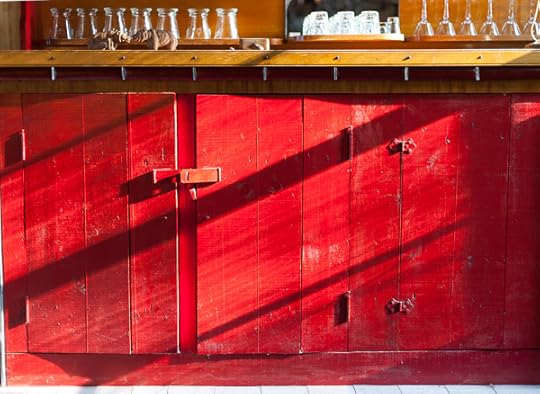
The cabin we were in belongs to Joanie’s family, she’s been coming there for seventy years. Love the slanting afternoon sun on the red doors under the bar.
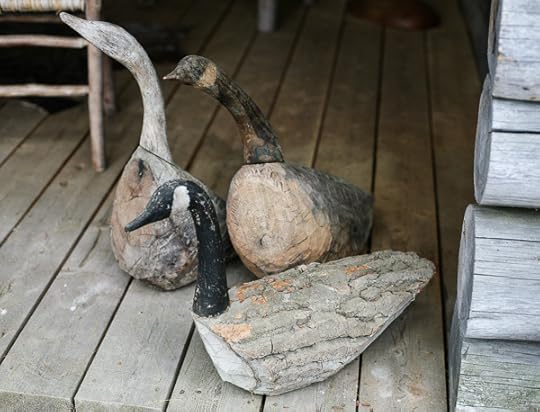
She had three cool decoys, I think the local Algonquin Indians made them.
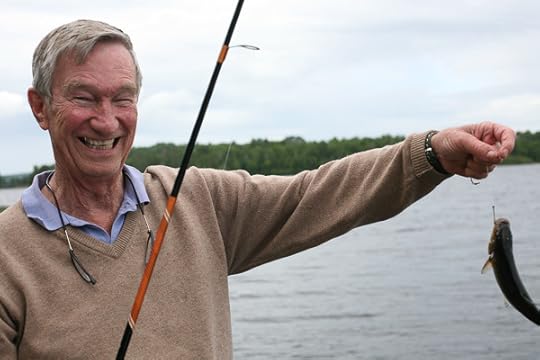
My brother Embry and I did a little fishing—this one went back in the water. On two days we went out with an Algonquin guide, a man whom Joanie had known for about fifty years.
I almost caught a pike, a really nice kind of big Canadian lake fish. The epic had four acts: (1) I hook him, about two feet long, get him close to the boat, he’s fighting and thrashing and twists free of the hook. Should have used a net, but we didn’t have one.
(2) Boat back to Embry and Joanie’s cottage, have lunch, rest, and return to this same beautiful little inlet off the intricate fractal river/lake waterways with a net. Our guide Don hooks a pike, maybe the very same one. I get the net, Don reels him in—after letting him run out the line three or four times, tiring him—I get the net half around the pike, the lure snags on the net, the pike twists free.
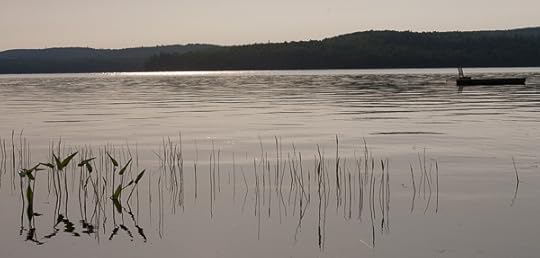
(3) The next morning Embry and the guide go out without me and return with… “A perch,” Sylvia tells me. “I think it was a big perch.” But, no, it’s a pike! Don cooks him for our dinner, breading him and frying him in chunks in bacon grease, it’s good to eat him.
(4) That evening I motor back to the special inlet with Embry and Don, and I use the same lure that Don used, but the original Magic Pike isn’t there.
The lake water wasn’t all that cold at Joanie’s, and the water had that limp, kind of jelly-like smoothness of fresh water. I went swimming every morning.

They had one antenna with a wireless connection, and we’d walk over to the little log building where it lived, the “temple of the internet” and get our fix. They had cool old junk hanging on the walls in there, just like at Dick Scheinman’s house on the Lost Coast.
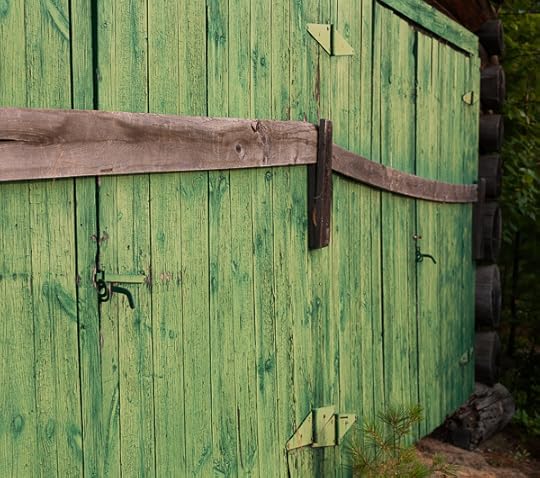
Not that anything important was coming in. But at this point we’re so much in the habit of checking email, Twitter, Facebook, etc., that it feels like basic life support.

[This is a cast aluminum house-shaped sculpture we saw in Vancover in the harbor. More about Vancouver in a later post.]
While I was in Vancouver and on the plane to Ottawa, and at the lake, I read Roadside Picnic, the late 1970s Russian SF novel by Boris and Arkady Strugatsky—I’ve heard about it for years, but hadn’t read it, and now I’d picked up a new edition at Powell’s Books in Portland.
A really admirable book, starting with the great premise that some aliens stopped on Earth, as if for a roadside picnic, and left all sorts of debris in a “Zone” they polluted. And the stuff is, for us, incredibly useful and terminally incomprehensible. The Strugatsky boys (and their English translator) made up lots of cute names for the debris. Happy ghosts, empties, golden sphere, grinder, bug traps.
The book has an exhilirating, heart-breaking ending. It’s a masterpiece.
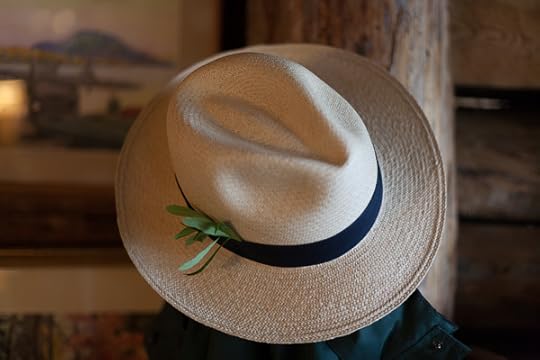
In my current lost-in-the-woods state regarding my next novel, I naturally start thinking that I might learn some lessons from Roadside Picnic.
The miracles in the book are intriguing and staggering, but they’re kind of peripheral. The very fact that the miraculous alien tech isn’t spelled out makes it that much more alluring. The Strugatsky boys leave you the room in which to dream. Borges’s Tlön, Uqbar, Orbum Tertius was similarly sketchy and suggestive.
The emphasis is always on character—with a lot of repeating inner monologues. What I call wheenk. The wheenk is really the core of the book. I typically have a higher action/wheenk ratio than in Roadside Picnic. But perhaps readers like a lower ratio than the one I’m typically using.
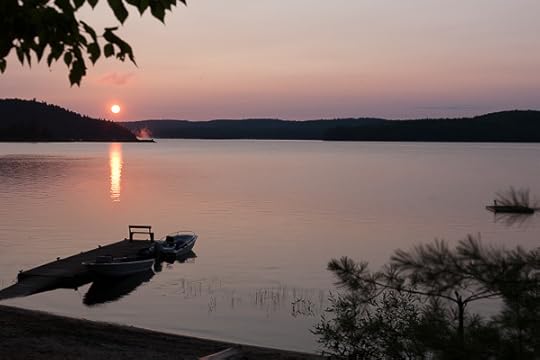
And then I read a travel book in the cottage, Evelyn Waugh, A Bachelor Abroad: A Mediterranean Journal. Written in 1929, after Waugh’s novels Decline and Fall and Vile Bodies. Great fun. Love his style, his dry wit, his snobbery.
This is a classic found-in-a-summer-cabin book, a nice clean hardback first edition, inscribed by the original owner on December 25, 1933. Great to spend a week outside of time.
July 29, 2014
Roadtrip #2. With Dr. Dick on the Lost Coast
I’ve always been intrigued by the area of Northern California known as the Lost Coast. This is where the coastal mountains plunge so sharply into the sea that coastal Route 1 bends away from the shore, heads inland, meets Route 101, and expires.
Route 101 runs along north through the redwoods, inland, and eventually bends back to the coast at Eureka through the redwoods.

The zone between 101 and the coast is the Lost Coast, featuring only a few tiny hamlets such as Shelter Cove and Petrolia—these are towns with populations in the 100s, not the 1000s. Some of the land is undeveloped forests, and some of it is carved up into private ranches, quite a few of which are said to contain greenhoused pot farms, or “grows.” The South Humboldt wholesale pot trade centers on the Route 101 town of Garberville.
I’d thought Garberville would have a festive carnival atmosphere, but far from it. The place is gloomy and tattered. Grim. We were glad to turn off at Garberville and head into the true Lost Coast.
The Lost Coast roads are narrow and winding, and the citizens are highly independent. During our long drive to Petrolia, deep in the heart of the wilderness, we smelled the heavy pot fragrance from several of the solar-battery-powered grows—not that we could readily see them from the road, and not that we were going to nose in and look for them.

The journey led us to my old college friend Dr. Dick Scheinman, who, far from being a pot-grower, has been the resident physician of Petrolia, CA, for going on forty years. He’s an idealistic sort, a thoroughly admirable man. He came the the Lost Coast because he wanted to live somewhere away from civilization “in a place where they speak English and where the rivers aren’t full of parasites.”
After several tries, I’d managed to reach Dick on his landline phone, and he told me the landmark for finding his house would be “a truck and a tree.” This seemed a little vague—I didn’t initially grasp that the truck would be in the tree. Dick and his kids hoisted the thing up there some years ago, having removed the engine and transmission to lighten the payload. Why? Because they could. And, since it’s the Lost Coast, no pesky officials were likely to say no. The officials don’t get out that way very often.

Dick is so self-reliant that he built his own home.
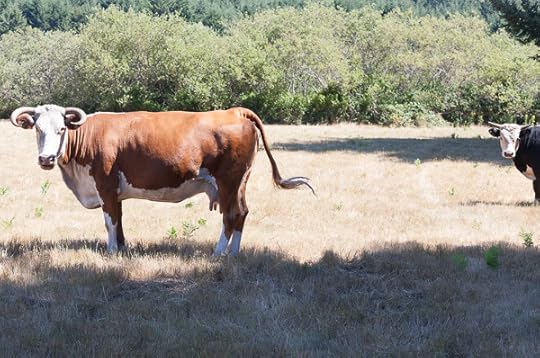
And he farms his own cows—he grilled us hamburgers made from them. Did he use a propane-fueled Weber BBQ set up? Hardly. He propped an old refrigerator rack on rocks over a wood fire, broiled the burgers and some green peppers Sylvia and I had in our car, and served the food on home-made pottery plates. No knifes and forks. Dick digs the clay for his pottery from the river and fires his creations in a wood-fired kiln he built. We’re talking serious D.I.Y. ethic here!

For city slickers like Sylvia and me, it was paradise to be so far off the grid. Dick took us swimming in a river a couple of hundred yards away. His house used to be next to the river, but the river moved. He and his neighbors have a provisional papala set up for shade.
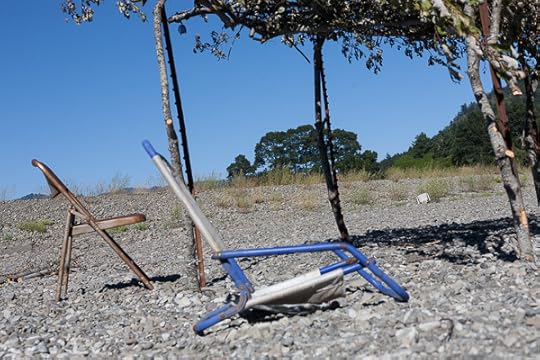
And they do have some store-bought chairs. I like this particular photo, I feel like it captures a little bit of that calmness I felt while visiting our friend. No traffic sounds, no airplanes overhead, no wireless, no cellphone, no rush.

Dick’s friends and the neighborhood dogs were all very pleasant—no cracked, dangerous, types were in evidence. We picked a zillion blackberries off Dick’s monster rows of bushes.
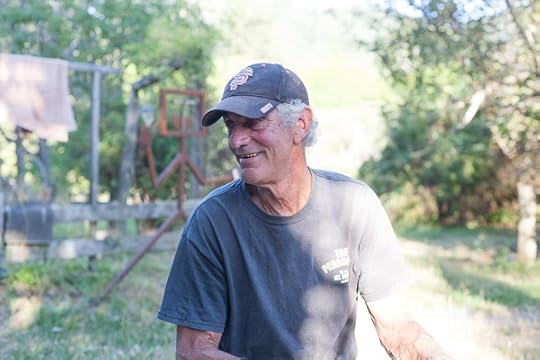
Our kindly host.
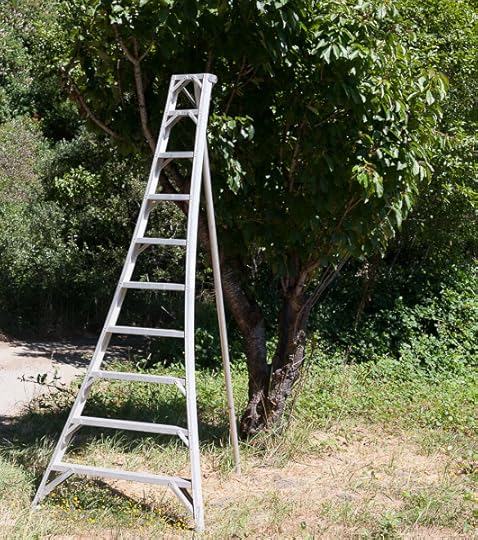
I shot a lot of photos. I had my old heavy-duty Canon 5D SLR with me, and all around me were the kinds of things I like to look at. A ladder for picking peaches, a stairway to heaven.
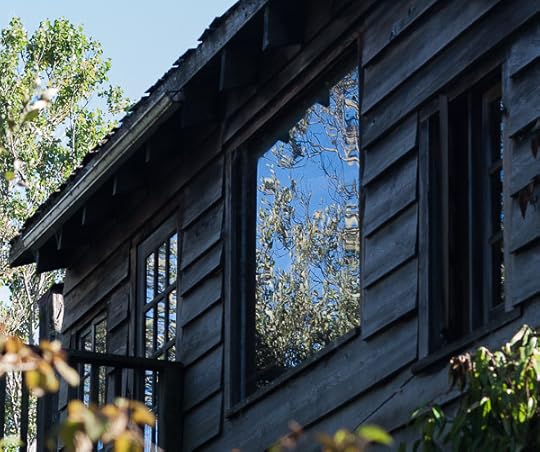
The late afternoon colors reflected in an upstairs window, the glass surface rippled with the ambient gnarl.

The back steps you go down on your way to the outhouse.

Two hoses on the ground, so lovely.

A tree and a field. What more do you want? Okay, a shed and some kindling and a float.
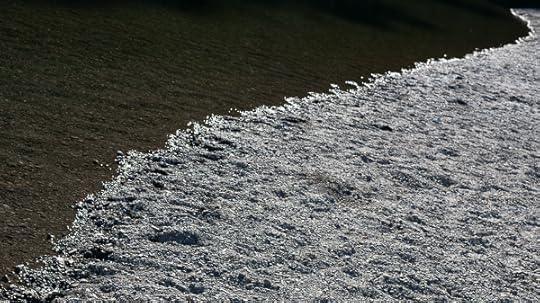
The living yin/yang of the river’s edge.
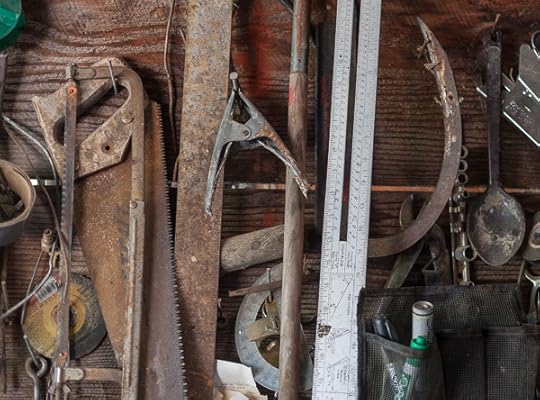
The wonderful toolshed walls, bedecked with wonder. Seeing this, I thought of the famous “Pied Beauty,” written by Victorian poet Gerard Manley Hopkins in 1877.
Glory be to God for dappled things –
For skies of couple-colour as a brinded cow;
For rose-moles all in stipple upon trout that swim;
Fresh-firecoal chestnut-falls; finches’ wings;
Landscape plotted and pieced – fold, fallow, and plough;
And all trades, their gear and tackle and trim.
All things counter, original, spare, strange;
Whatever is fickle, freckled (who knows how?)
With swift, slow; sweet, sour; adazzle, dim;
He fathers-forth whose beauty is past change:
Praise him.

And seeing this cow, I think of Peter Bruegel’s painting, Return of the Herd. Cows are wider than we tend to realize, and Bruegel knew to paint them that way. Scheinman hypotheses that, with all that cud fermenting inside their stomachs, cows all times have a bit of a buzz on. Calm and bovine. Dick likes his cows a lot, like pets, even though he eats them. It’s the wheel of life. He doesn’t actually make any profit on them, but it feels right to have them around.
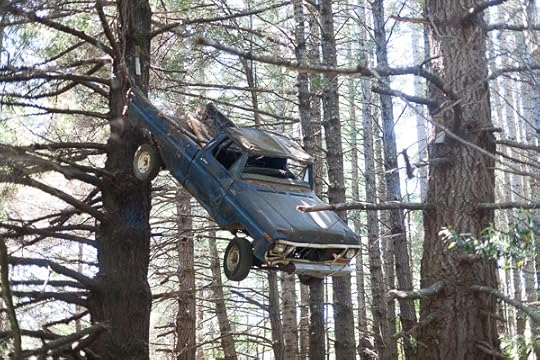
On the way out, Sylvia and I took one last look at the dangling truck.
We hit the fiercely wild Lost Coast beach at the mouth of the Mattole River near Petrolia, then wound our way along the insanely scenic and bumpy Mattole road to RV-filled Route 101, hitting gorgeous Bandon, Ore, for a night, and then, feeling pressed for time, stemmed off along a two-laner beside the lovely Umqua River to reach the congested nightmare of Interstate I-5 North. Eeeek.

Near Seattle, we spent a night with my SF writer pal Marc Laidlaw. I always love talking to him. Marc and I don’t live like rugged pioneers, but we’ve turned out some good surfin’ SF stories over the years. Our latest extravganza, “Watergirl,” will be in Asimov’s SF magazine this fall, featuring our usual transreal surfin’ SF doubles, Zep and Del.
Seek ye the gnarl, dude.
July 27, 2014
Roadtrip #1. Seastacks.
A couple of weeks ago, my wife Sylvia and I set out for a drive along the coast from San Francisco to Vancouver.
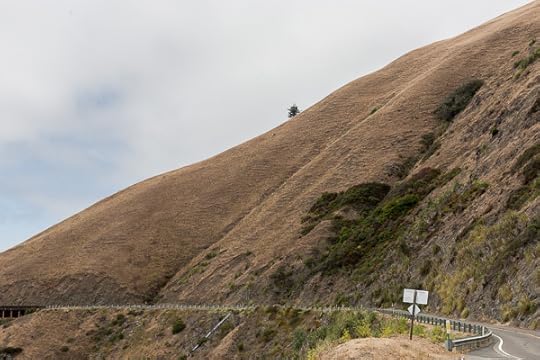
We stuck to Route 1 most of the way, it’s a slow two-laner, but it’s great to be by the ocean. As opposed to being on a giant interstate like Rt. 5. This said, we did take Rt. 5 for most of the way home…two weeks later.
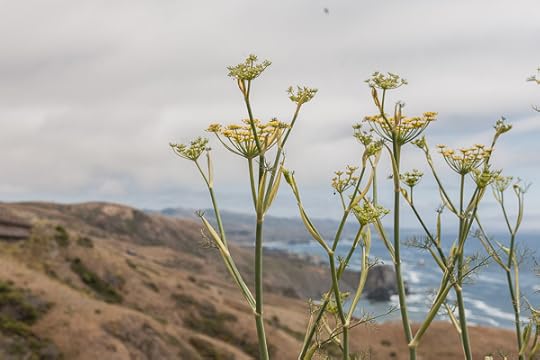
I’d always been curious about the Sea Ranch development on the coast north of SF, but it’s kind of boxy. Good cliffs, though. And a bathroom.

Further north in California we got to the redwood zone. Love those ferns and the greenness.
Later we stopped at a giant log that had been hollowed out to be a trailer home and dragged around the country in the 1940s. Checked out a tree we could drive our car through. And then what?

We saw a lot of big rocks in the ocean, they call them “seastacks.” A cute young couple climbed one of them and hugged.
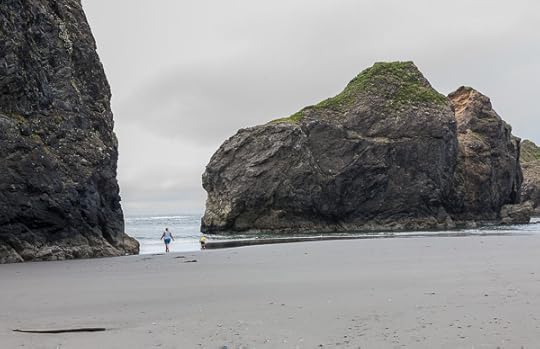
In northern California, south of Eureka and Arcadia, Route 1 veers away from the ocean because the coast is too intensely rocky, and there’s an area called the Lost Coast where we visited our old college friend, Dick Scheinman. But I’ll save that for the next blog post.
For today let’s jump ahead into driving Rt. 1 along the Oregon coast. We started getting to really big seastacks up there. You feel like an ant among them, which is always a nice feeling.

The greatest seastacks were in a town called Bandon, Ore. You can remember it as Abandon without the A. We stayed at the inexpensive old Bandon Beach Motel near the Coquille Point, where there’s a serious buttload of seastacks.
Pan shot of the stairs down to the beach from the motel.
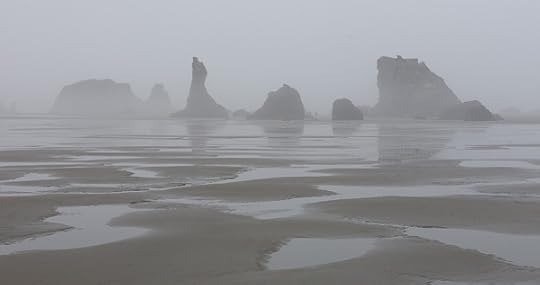
In the morning it was misty and the tide was low. I walked along the beach for an hour, getting some really nice pictures. It was like being in a painting by Yves Tanguy. You used to see a lot of book covers like this on SF novels in 1950s and early 1960s.

Exquisite reflections and patterns, and the little birds animating the scene.

I was totally, totally into it, natch.

I talked to an old guy who was digging for clams. He’d stick this tube into the sand to, like, chase them down as they were digging to get away from him. He wasn’t having a good day, he’d only bagged about four of them.

Intense wads of anemones as well.

Sylvia came down on the beach, too, and we found a piece of “driftwood” nearly the size of a house. Wonderful gnarl.

And the source code is pocks in the rocks.
July 4, 2014
SF Cliffs, Carnival Rides, Digital Pub, “Gorgeous” Show
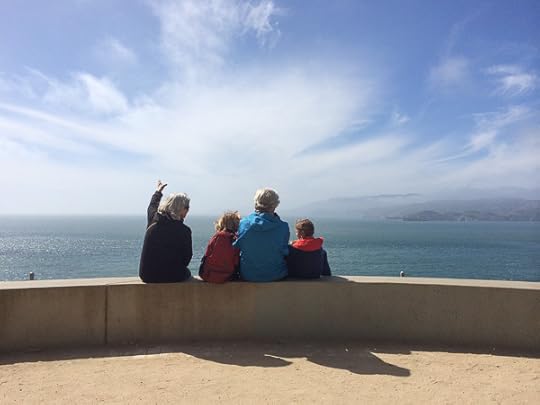
A few weeks ago my wife and I took two of our grandchildren to the Legion of Honor museum in SF, and then the four of us walked south along the clifftops towards Land’s End, and we sat for awhile on a wall looking out at the sea. The big sky. The future. A lady named Chloe, sitting on a bench behind us, took a photo of us and emailed it to me. She’d somehow attached her iPhone to her heavy-duty SLR camera. Wonderful shot.
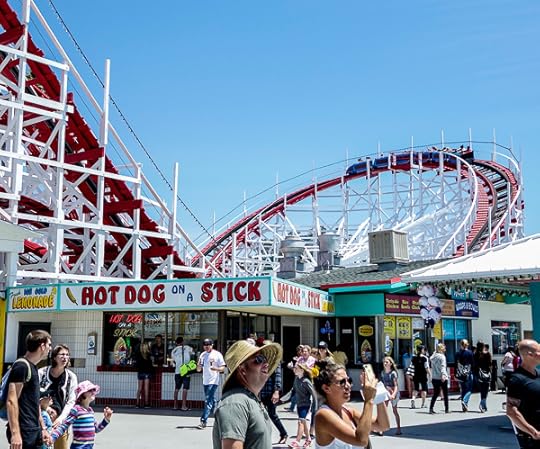
Sylvia’s niece came to visit and we took her and her family out to the Boardwalk at Santa Cruz. (This isn’t the family in the photo.) I love going to the Boardwalk. It’s a park where you pay as you go, paying for each ride separately. So you don’t have to commit to a full day of pukeful chaos.
The only thing I rode was the Big Dipper roller coaster. When we hit the bottom after the first big down-swoop, about half the vertebrae in my lower back and in my neck made little pops. For lack of any other reasonable option, I decided this was good for me. Like a trip to a chiropractor…not that I ever go. I felt loose and wiggly. Glad to have survived yet another “my last ride ever on the Big Dipper.”

There is no ride more terrifying to me than a chair swing ride. For reasons unclear to me, I think of them as being “Swiss Swing” ride, but I don’t think anyone else uses this phrase.
I think I first got really really scared of them when Sylvia and I rode one at a small town Upstate New York carnival in, like, 1976, and the chains were totally puny, like chains you’d have on a swing in your backyard, and we were sure one of them would break. To make I worse, we were swinging out over a crushed, blood-stained “death-car” that the cops had carted to the carnival site to frighten potentially reckless teen drivers.
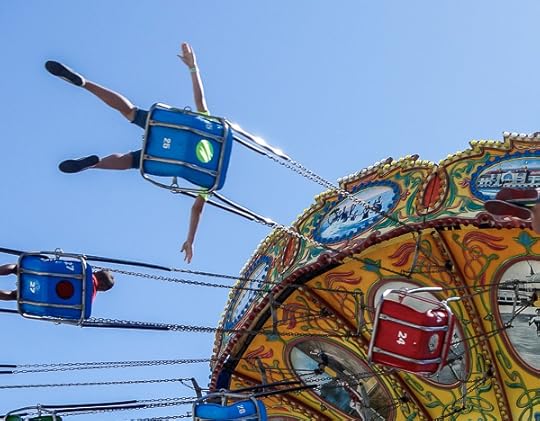
Look, Ma, no head!
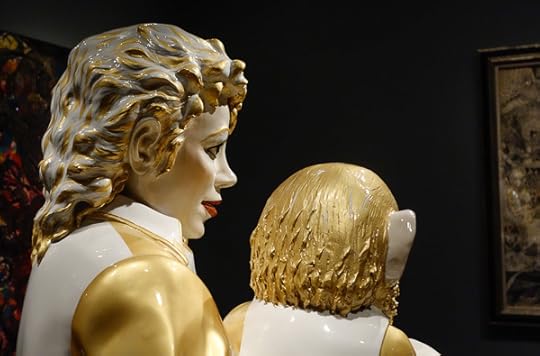
Last week I was in SF for digi.lit, which is LitQuake’s conference about how to succeed in digital publishing. The talks (including mine) weren’t super interesting, although I did pick up a few tips, and I met some nice people. One suggested tactic that I might try, at some point, will be to pay to be part of a mass ad emailing by an outfit called BookBub. Publicity being the biggest prob for self publishers.
My new books, I feel I should mention yet again, are my Beat memoir/novel All the Visions and my SF Transreal Trilogy: Secret of Life, White Light, and Saucer Wisdom.
Skipping some of digi.lit talks, I went to the nearby Museum of Asian Art, where they have a really interesting show called Gorgeous. They’ve paired pieces from their collection with pieces from the temporarily-closed SF MOMA. I’ve always liked the big Koons sculpture of Michael. Koons really is a Warhol for our age. He employs, like, 120 people to fabricate his works, truly a factory process.
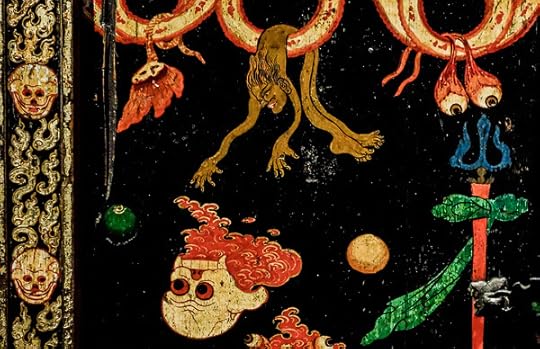
The Tibetan Buddhists have a wonderfully gory notion of art that makes you think about the end of the road. Dangling eyeballs, skull brimming with blood’n’brain, what more do you want?
Speaking of fabricating off-kilter works of art, I’m working (slowly) with Bruce Sterling on a new story.
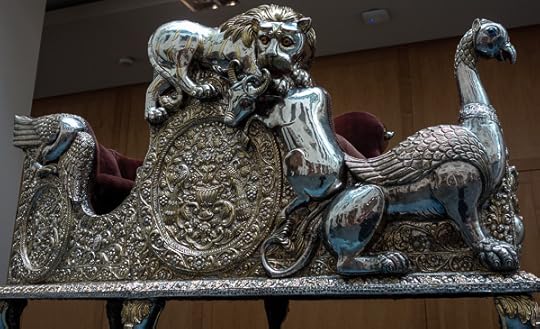
Love the word “howdah.” It means the seating cabin that you set on top of a royal elephant. This was in that Glamour show as well.
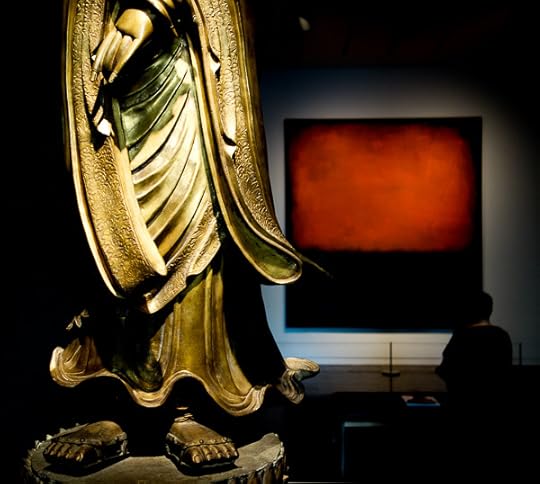
The final room of the show is a really strong jolt, quite wonderful. In back, a dimly lit Rothko, in the front, a wonderfully crafted bronze sculpture of a Buddha of some kind. I opened up my head inside this room, forgetting myself or, rather, watching the pieces of myself float by. Best art-rush I’ve had in a long time.
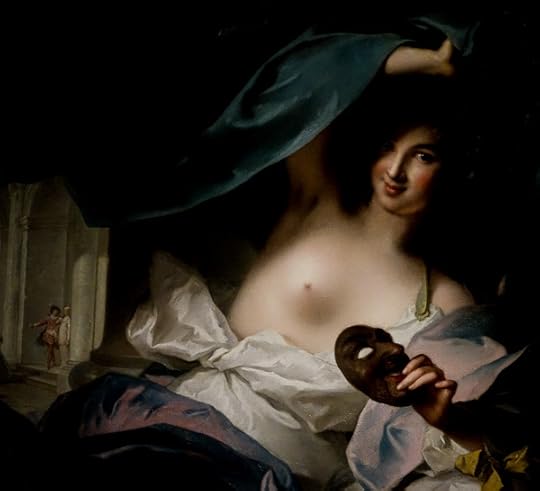
Oh, one more painting I saw this month, this one at the Legion of honor. It’s a smoothly painted and equivocal rendering of Thalia, the muse of comedy. Given a choice (not that you always are), I’ll always choose comedy over tragedy.
July 1, 2014
Looking for Visions

Photo by Susan A. Poague.
I was out at Four Mile Beach north of Santa Cruz with my wife and some friends yesterday. Pulling on a piece of kelp here, wanting to extract a nice long tentacle. The stalk snapped, I fell on my butt, it was fun. A jolt.
This month I read a picture book by Chet Van Duzer, Sea Monsters on Medieval and Renaissance Maps. Found it in Strand Books in NYC. A fascinating theme—and very fitting for me, as I’m in the process of deciding what to put in my next SF novel. Looking for the funky, gnarly monsters that live beneath the blank spaces of my world map.

Here’s a detail of the best and most influential monster-bedecked map of the sixteenth century. By Olaus Magnus.
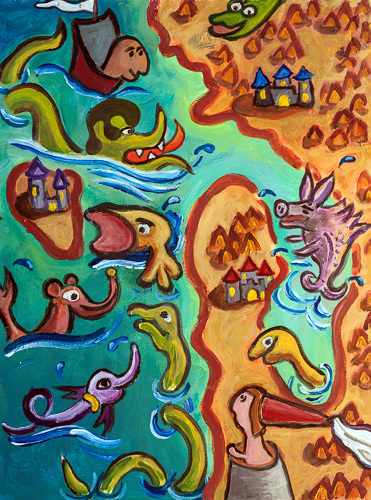
“Sea Monsters” acrylic on canvas, June, 2014, 18” x 24”. Click for a larger version of the painting.
So I went and did my own sea-monsters-map painting. Something that made me laugh was the fact that the old-timers believed that every kind of land animal had a sea version. A lot of their confused ideas arose, I think, from occasional glimpses of seals, sea lions, and walruses. Be that as it may, they were sure we could find a sea pig, a sea elephant, a sea Elvis, whatever.
To finish off the narrative of my painting, I put in a youth questing for a princess in a tower. Her expression cracks me up. She’s bewildered, bemused, like, “Oh no.”
On the painting front, I published a new edition of my Better Worlds book of my paintings. You can buy it in paperback or, more immediately, you can browse it for free as a big webpage. It takes a minute to load this page the first time, but it should load pretty fast after that.

Good news from NYC! Dover Books will be reissuing my early nonfiction book The Fourth Dimension this fall. And they made a nice cover. I dig the green, and the mathematical rabbit-hole in the middle, and the transparency of the subtitle. I wrote a short new preface.

Meanwhile I’m just trying to do my jigsaw puzzle before it rains anymore. The puzzle is what goes into the next novel. Dig this book skimming across my dining table like a flying fish. This book is a useful enlightenment book called It’s Up To You by the Tibetan guru Dzigar Kongtrul. The thoughts and emotions in my head aren’t “me,” nor is there any “me” to have a head. So “I” can relax. Let the clouds drift.
Yes! But meanwhile I want to write another novel anyway. Writing helps me forget that I’m alive—a goal for many an artist. First I’d thought my next book might be a YA (young adult) book about an NYC kid. And then I’d thought it might be a sequel to Frek and the Elixir. And today I’m thinking it might be kind of a YA novel—but about an alien on another world. A, like, lizard boy, disturbed by thoughts of fragrant scales and leathery-skinned eggs. Only something stranger than that. I could dream up a whole cosmos, or at least a one-molecule-thick FX illusion of one.

Long story short, I’m looking to escape from consensus reality once again. Alone with the dino-birds in the cosmic stadium. Pull that stalk.
June 25, 2014
Two New Books! TRANSREAL TRILOGY & ALL THE VISIONS
*Two new books out in ebook and paperback today!
* Transreal Trilogy and All The Visions.
*Click the cover images below to visit the book pages.

Transreal Trilogy book page.
Transreal Trilogy includes three of my “transreal” novels, that is, SF about my own life.
* The Secret of Life: A 60s college student learns he’s a saucer alien.
* White Light: A hipster math professor travels to the afterworld.
* Saucer Wisdom: A troubled author tries to write about alien abductions.

All The Visions book page.
All the Visions is a short autobiographical novel that I wrote in 1983. Wanting to emulate Jack Kerouac’s composition of On the Road, I typed All the Visions on an 80-foot scroll of paper instead of using separate sheets. The book describes the adventures of Conrad Bunger: mathematician, writer, seeker, rebel, freak.
Browse Transreal Trilogy and All The Visions for free on their book pages.
Buy the books at Transreal Books.
Many thanks to the 170 people who backed this publication project on Kickstarter.
It’s a new world in publishing.
And I’m still rockin’.
The mystery tour is now boarding.
Rudy Rucker's Blog
- Rudy Rucker's profile
- 583 followers





